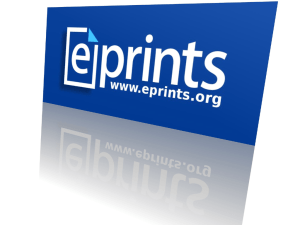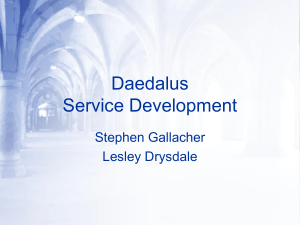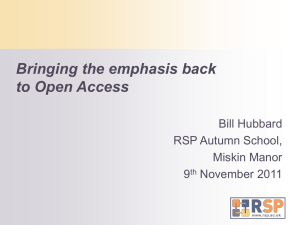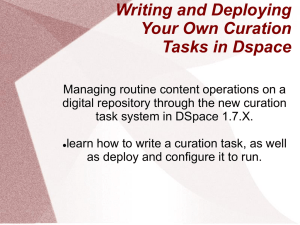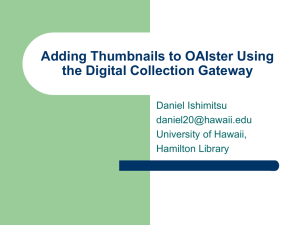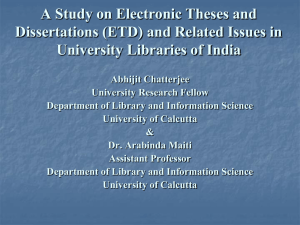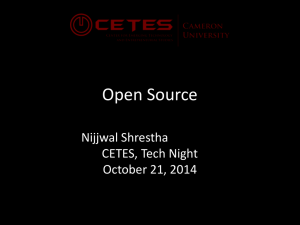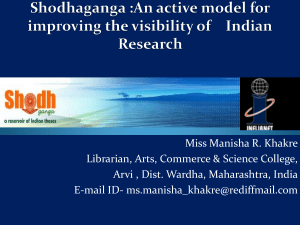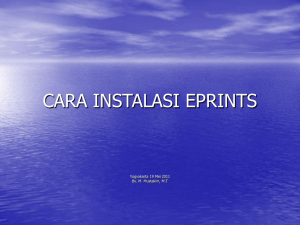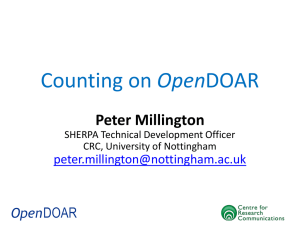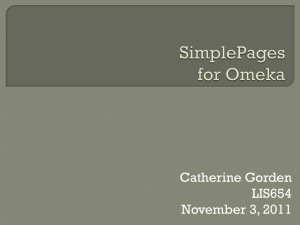Step 1: /usr/share/eprints3/archives/archivename/cfg/subjects Step 2
advertisement
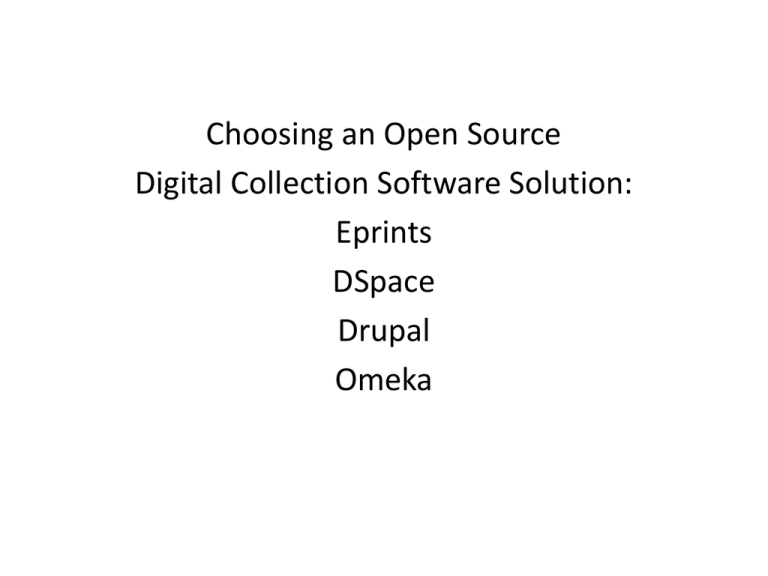
Choosing an Open Source Digital Collection Software Solution: Eprints DSpace Drupal Omeka Joseph Fisher Database Management Librarian @ UMass Lowell Digital Commonwealth Executive Committee Student in the University of Arizona SIRLS Graduate Certificate Program in Digital Information Management (DigIn) digin.arizona.edu Objective Five stages of implementation: 1. 2. 3. 4. 5. Installation (DSpace) Branding Collection setup Item ingest User Interface LAMP • • • • Linux Apache MySQL PHP/Perl • Eprints • Omeka • Drupal • • • • • Linux Tomcat PostgresSQL Java JSP/XSLT DSpace • EPrints • DSpace • Drupal • Omeka EPrints • • • • • University of Southampton, UK First released (v 2.0) 2002 Current version 3.2.7 (v3 2006) Linux / Windows (Perl) “EPrints is … the easiest and fastest way to set up repositories of open access research literature, scientific data, theses, reports and multimedia.” EPrints : Key Features • software links to the SHERPA/RoMEO database so authors can easily verify their publisher policies • LCSH framework included that can be manually expanded • Supports internal and external authority files or auto-fill from previous database entries. • Multiple item import and export options • Thumbnails and preview images of search items EPrints: Branding Step 1: /usr/share/eprints3/archives/archivename/cfg/subjects Step 2: Step 3: $ bin/import_subjects archivename filename Step 1: /usr/share/eprints3/archives/archivename/cfg/subjects Step 2: Step 3: $ /bin/import_subjects <archive id> -xml Collection “Division” Setup EPrints: Item Ingest EPrints Conclusion • Easy to install, easy to brand, best for a single subject-specific repository • Designed for documents, though now supports multiple file types • Easy embargo, default thumbnail and preview • Some preservation support – History module for tracking changes, METS export plugin • V3 does enable easier development of plugins (20-30 listed per year) EPrints: Challenges • Not all Dublin Core fields provided (relation, source, contributor, coverage) • Lack of theme options • Possible with Views to create custom collection space within a repository? • Statistics? Permissions? Plugins? • Documentation not well developed • EPrints • DSpace • Drupal • Omeka DSpace • • • • • HP-MIT Libraries Alliance (2002) DuraSpace (2009) Current version 1.7.1 (2.0 due in Oct.) Linux / Windows (Java) “DSpace preserves and enables easy and open access to all types of digital content including text, images, moving images, mpegs and data sets.” DSpace : Key Features • Preservation support: Bit integrity checker, format registry, item history, handles, DuraCloud backup • Discover faceted seach/browse interface • Qualified Dublin Core base or MODS thru xmlui • Embargo capability • OAI-PMH harvesting, both data and service supplier • Manakin XMLUI provides flexible though challenging customization capability (multiple custom archives) Dspace: Installation Prerequisite Software : • • • • • • • Linux or Windows Oracle Java JDK Maven (Java build tool for stage 1) Ant (Java build tool for stage 2) PostgreSQL or Oracle Tomcat Perl JSPUI: Java Server Pages User Int. XMLUI : Manakin (default theme) /dspace/config/xmlui.xconf Stop / Start Tomcat Kubrick theme @Mire Mirage Theme http://demo.dspace.org/xmlui Changing home page XMLUI /dspace/config/news-xmlui.xml New Preservation Tool: 1.7 OAI Harvesting DSpace: Conclusion • Very functional out of the box with easy branding • Increasing preservation management support (PREMIS support coming in v2.0) • Good documentation, training materials, and broad support base • Platform is versatile and flexible with ability to customize collection interfaces • OAI-PMH/ORE/SWORD (postponed) • SOLR-based statistics engine • Metadata registry, option to add new schemas DSpace: Challenges • Research Projects: – Discovery faceted search – Embargo – DSpace Statistics – Thumbnails – XMLUI Customization • EPrints • DSpace • Drupal • Omeka Drupal • Became Open Source project (2001) • Current version 7 (Jan. 2011) • Content Management Framework (CMF) • LAMP / Windows (PHP) • “Drupal … allows anyone to easily publish, manage and organize a wide variety of content on a website. .” Drupal: Key Features • Numerous themes • Extensive module availability: – Custom Control Kit (CCK) – allows creation of fields for input and display – Faceted Search – Image administration – Advanced Search – Views – create customized lists and queries – OAI-PMH module Drupal: Conclusions • Flexible and versatile but takes time and effort to put all the pieces together • Large, varied, and active community of users and developers with good documentation • Limited only by module availability, of which there are nearly 8,000 (back to version 4.x) • Challenges: modules are managed individually and the entire structure manually constructed • EPrints • DSpace • Drupal • Omeka Omeka • Center for History and New Media at George Mason University (2008) • LAMP / Windows (PHP) • V 1.3.2 (2011) • “Omeka is a free, flexible, and open source webpublishing platform for the display of library, museum, archives, and scholarly collections and exhibitions.” Omeka: Key Features • “Designed with non-IT specialists in mind” • “as easy as launching a blog” • Over a dozen themes • Over 30 Plugins: – – – – – – OAI-PMH Harvester Exhibit Builder LC Subject Headings Comments Social Bookmarking Item Relationships Omeka.net • Cloud web hosting • Five tiers: – 500MB for free with 1 site, 4 plugins, 4 themes – Tier 1 = $49 for 1GB, 2 sites, 6 plugins – Tier 4 = $999 for 25GB, unlimited sites and plugins Omeka: Conclusion • Extremely easy plug and play functionality • Exhibit plugin enables easy customized collection interfaces • Immediate metadata field additions • Limited user and development base, but still new and growing • Very easy OAI-PMH capability Why Open Source? Mission: Open source is a development method for software that harnesses the power of distributed peer review and transparency of process. The promise of open source is better quality, higher reliability, more flexibility, lower cost, and an end to predatory vendor lock in. The Open Source Initiative (OSI) http://www.opensource.org/ Lower Cost !!??!! • • • • Server Technical-savvy staff Programmer? Time Choice Criteria • • • • • • • • • Institutional Repository or Digital Archive Ease of use Metadata flexibility OAI Harvesting File format support Multiple collection interface customization Popularity / Reputation Size of active community Development commitment Insource Outsource “…two major problems … First, the core mission of for-profit service providers is not to preserve and provide access to significant digital objects. It is, however, to generate a profit and stay in business…. Second, if an outsourcing trend takes hold and gains momentum, then cultural institutions are at great risk of losing their own value proposition and viability as institutions in the digital age.” Tyler O. Walters, Katherine Skinner. “Economics, sustainability, and the cooperative model in digital preservation.” Library Hi Tech (28.2) 2010 Librarians of the World Unite!! We have nothing to lose!! Control the means of Production!!
